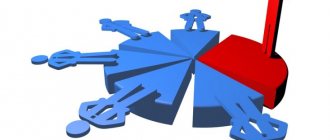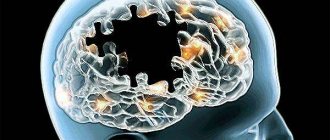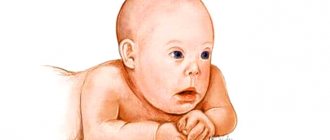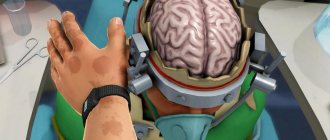Adolescents with emotional-volitional disorders
The main types of disorders in the development of the emotional-volitional sphere in children and adolescents include reactive states
(hyperactivity syndrome),
conflict experiences, psychasthenia
and
psychopathy (psychopathic forms of behavior).
As is known, a child’s personality is formed under the influence of hereditarily determined (conditioned) qualities and factors of the external (primarily social) environment. Since the development process largely depends on environmental factors, it is obvious that unfavorable environmental influences can cause temporary behavioral disorders, and once they become established, they can lead to abnormal (distorted) personality development.
Just as normal somatic development requires an appropriate amount of calories, proteins, minerals and vitamins, normal mental development requires the presence of certain emotional and psychological factors. These include, first of all, the love of neighbors, a sense of security (provided by the care of parents), the cultivation of correct self-esteem, and also, along with the development of independence in actions and behavior), the guidance of adults, which includes, in addition to love and care, a certain set of prohibitions. Only with the correct balance of attention and prohibitions are appropriate connections formed between the child’s “I” and the outside world, and the child, while maintaining his individuality, develops into a personality that will find its place in society.
The versatility of the emotional needs that ensure the development of a child, in itself indicates the possibility of a significant number of unfavorable factors in the external (social) environment, which can cause disturbances in the development of the emotional-volitional sphere and deviations in the behavior of children.
Reactive states
are defined in special psychology as neuropsychic disorders caused by unfavorable situations (developmental conditions) and not associated with organic damage to the central nervous system. The most striking manifestation of reactive states (RS) is hyperactivity syndrome, which appears against the background of a “prolonged” state of general mental excitability and psychomotor disinhibition. The causes of MS can be varied. Thus, circumstances traumatic for a child’s psyche include such a psychophysiological disorder as enuresis (bedwetting, persisting or often recurring after three years of life), often observed in somatically weakened and nervous children. Enuresis can occur after a severe nervous shock, fright, or after a somatic illness that debilitates the body. The occurrence of enuresis also includes such reasons as conflict situations in the family, excessive strictness of parents, too deep sleep, etc. Reactive states with enuresis are aggravated by ridicule, punishment, and the unkind attitude of others towards the child.
A reactive state can be caused by the presence of certain physical and psychophysiological defects in a child (strabismus, deformities of the limbs, lameness, severe scoliosis, etc.), especially if the attitude of others is incorrect.
A common cause of psychogenic reactions in young children is a sudden strong irritation of a frightening nature (fire, attack by an angry dog, etc.). Increased susceptibility to mental trauma is observed in children with residual effects after suffering infections and injuries, in children who are excitable, weakened, and emotionally unstable. Children with a weak type of higher nervous activity and easily excitable children are most susceptible to mental trauma.
The main distinguishing feature of MS is inadequate (excessively pronounced) personal reactions to influences from the environment (primarily social) environment. Reactive states are characterized by a state of psychological tension and discomfort. MS can manifest itself in the form of depression (sad, depressed state). In other cases, the main symptoms of MS are: psychomotor agitation, disinhibition, and inappropriate behavior and actions.
In severe cases, a disorder of consciousness may be observed (confusion, loss of orientation in the environment), causeless fear, temporary loss of certain functions (deafness, mutism).
Despite the difference in manifestations, a common “symptom” connecting all cases of reactive states is a severe, depressing psycho-emotional state, causing overstrain of nervous processes and impairment of their mobility. This largely determines the hanged tendency to affective reactions.
Mental development disorders may be associated with severe internal conflict experiences
when in the child’s mind there are opposing attitudes towards close people or to a particular social situation that has great personal significance for the child.
Conflict experiences (as a psychopathological disorder) are long-term, socially conditioned; they acquire a dominant
significance in the mental life of the child and have a sharply negative impact on his characterological characteristics and behavioral reactions. The causes of conflict experiences are most often: the unfavorable position of the child in the family (conflicts in the family, family breakdown, the appearance of a stepmother or stepfather, parental alcoholism, etc.). Conflict experiences can arise in children abandoned by their parents, adopted, and in other cases. Another reason for persistent conflict experiences may be the above-mentioned shortcomings and defects in psychophysical development, in particular, a severe form of stuttering.
Manifestations of severe conflict experiences most often include isolation, irritability, negativism (in many forms of its manifestation, including speech negativism), depressive states; in some cases, the consequence of conflict experiences is a delay in the child’s cognitive (intellectual) development.
Persistent conflict experiences are often accompanied by violations (deviations) of behavior. Quite often, the cause of behavioral disorders in this category of children is improper upbringing of the child (excessive care, excessive freedom or, on the contrary, lack of Love, excessive severity and unreasonable demands, without taking into account his personal intellectual and psychophysical capabilities, determined by the stage of age development. A particularly serious mistake in raising a child is a constant derogatory comparison with children who have better abilities and the desire to achieve greater achievements from a child who does not have pronounced intellectual inclinations. A child whose dignity is humiliated and who is often punished may develop a feeling of inferiority, a reaction of fear, timidity, and anger and hatred. Such children, who are constantly stressed, often experience enuresis, headaches, fatigue, etc. At an older age, such children may rebel against the dominant authority of adults, which is one of the reasons for antisocial behavior.
Conflict experiences can also be caused by traumatic situations in the school community. Of course, the occurrence and severity of conflict situations is influenced by the individual personal and psychological characteristics of children (state of the nervous system, personal aspirations, range of interests, impressionability, etc.), as well as the conditions of upbringing and development.
Psychasthenia is also a fairly complex neuropsychic disorder.
– disturbance of mental and intellectual activity, caused by weakness and disruption of the dynamics of processes of higher nervous activity, a general weakening of neuropsychic and cognitive processes. The causes of psychasthenia can be severe violations of somatic health, violations of general constitutional development (due to dystrophy, metabolic disorders in the body, hormonal disorders, etc.). At the same time, factors of hereditary conditioning, dysfunction of the central nervous system of various origins, the presence of minimal brain dysfunction, etc. play a large role in the occurrence of psychasthenia.
The main manifestations of psychasthenia are: a decrease in general mental activity, slowness and rapid exhaustion of mental and intellectual activity, decreased performance, phenomena of mental retardation and inertia, increased fatigue under psychological stress. Psychoasthenic children are extremely slow to engage in academic work and get tired very quickly when performing tasks related to mental and mnemonic actions.
Children in this category are distinguished by such specific character traits as indecision, increased impressionability, a tendency to constant doubts, timidity, suspiciousness, and anxiety. Often, symptoms of psychasthenia also include depression and autistic manifestations. Psychopathic development according to psychasthenic
type in childhood manifests itself in increased suspiciousness, obsessive fears, and anxiety. At an older age, obsessive doubts, fears, hypochondria, and increased suspiciousness are observed.
Psychopathy
(from the gr. -
psyche
- soul,
pathos
- disease) is defined in special psychology as a pathological character pattern, manifested in unbalanced behavior, poor adaptability to changing environmental conditions, inability to obey external demands, and increased reactivity. Psychopathy is a distorted version of personality formation; it is a disharmonious development of personality with (as a rule) sufficient preservation of intelligence. Research by domestic scientists (V.A. Gilyarovsky, V.R. Myasishchev, G.E. Sukhareva, etc.) showed the dialectical interaction of social and biological factors in the origin of psychopathy. Most psychopathy is caused by external pathological factors that acted in utero or in early childhood. The most common causes of psychopathy are: infections - general and brain, traumatic brain injuries - intrauterine, birth and acquired in the first years of life; toxic factors (for example, chronic gastrointestinal diseases), intrauterine development disorders due to alcohol intoxication, exposure to radiation, etc. Pathological heredity also plays a certain role in the formation of psychopathy.
At the same time, for the development of psychopathy, along with the main (predisposing) cause causing congenital or early acquired insufficiency of the nervous system, it is necessary to have another factor - a disadvantaged social environment and the lack of corrective influences when raising a child.
Purposeful positive influence of the environment can, to a greater or lesser extent, correct the child’s existing deviations, while under unfavorable conditions of upbringing and development, even mild deviations in mental development can transform into severe Forma psychopathy (G.E. Sukhareva, 1954, etc.). In this regard, biological factors are considered as starting points, prerequisites that can cause psychopathic personality development; Social factors, mainly the conditions of raising a child, acquire a decisive role.
Psychopathy is very diverse in its manifestations, so the clinic distinguishes its various forms (organic psychopathy, epileptoid psychopathy, etc.). Common to all forms of psychopathy is a violation of the development of the emotional-volitional sphere, specific character anomalies. Psychopathic personality development is characterized by: weakness of will, impulsiveness of actions, rough affective reactions. Underdevelopment of the emotional-volitional sphere also manifests itself in a certain decrease in performance associated with the inability to concentrate and overcome difficulties encountered when performing tasks.
Violations of the emotional-volitional sphere are most clearly expressed in organic psychopathy
, which is based on organic damage to the subcortical brain systems. Clinical manifestations of organic psychopathy are different. In some cases, the first manifestations of a mental disorder are detected at an early age. The anamnesis of these children indicates pronounced timidity, fear of sharp sounds, bright light, and unfamiliar objects. Of people. This is accompanied by intense and prolonged screaming and crying. In early and preschool age, psychomotor restlessness and increased sensory and motor excitability come to the fore. At primary school age, psychopathic behavior manifests itself in the form of uncontrollability, protest against the rules of social behavior. Any regime, in the form of affective outbursts (pugnacity, running around, noisiness, and later – school absenteeism, tendency to vagrancy, etc.).
In other cases of organic psychopathy, the following feature of the behavioral reactions of children attracts attention, sharply distinguishing them from their peers already at preschool age. Relatives and teachers note the extreme unevenness of their mood; Along with increased excitability and excessive mobility, these children and adolescents often experience a low, gloomy, irritable mood. Children of senior preschool and primary school age often complain of vague pain, refuse to eat, sleep poorly, and often quarrel and fight with peers. Increased irritability, negativism in various forms of its manifestation, hostile attitude towards others, aggressiveness towards them form pronounced psychopathological symptoms of organic psychopathy. These manifestations are especially pronounced at an older age, during puberty. They are often accompanied by a slow pace of intellectual activity, decreased memory, and increased fatigue. In some cases, organic psychopathy is combined with delayed psychomotor development of the child.
G. E. Sukhareva identifies two main groups of organic psychopathy: excitable (explosive) and “inhibitory.”
At the first (excitable)
type, unmotivated mood swings in the form of dysphoria are observed. In response to the slightest remarks, children and adolescents have violent reactions of protest, leaving home and school.
Organic psychopaths of the uninhibited type are characterized by elevated mood levels, euphoria, and uncriticality. All this is a favorable background for the formation of a pathology of desires and a tendency to vagrancy.
With a hereditary burden of epilepsy, children may develop personality traits characteristic of epileptoid psychopathy.
This form of psychopathy is characterized by the fact that in children, with primary intact intelligence and the absence of typical signs of epilepsy (seizures, etc.), the following behavioral and character traits are noted: irritability, short temper, poor switchability from one type of activity to another, “getting stuck” on their experiences, aggressiveness, egocentrism. Along with this, thoroughness and perseverance in completing educational tasks are characteristic. These positive traits must be used as support in the process of correctional work.
With a hereditary burden of schizophrenia, children may develop schizoid personality traits. These children are characterized by: poverty of emotions (often underdevelopment of higher emotions: feelings of empathy, compassion, gratitude, etc.), lack of childish spontaneity and cheerfulness, little need for commonality with others. The core feature of their personality is autism. They are characterized by a peculiar asynchrony of mental development from early childhood. The development of speech outpaces the development of motor skills, and therefore self-care skills are difficult for children. In games, children prefer loneliness or communication with adults and older children. In a number of cases, the peculiarity of the motor sphere is noted - clumsiness, motor awkwardness, inability to perform practical activities. General emotional lethargy, which is detected in children from an early age, lack of need for communication (autistic manifestations), lack of interest in practical activities, and later - isolation, self-doubt, despite a fairly high level of intellectual development, create significant difficulties in education and teaching this category of children.
Hysterical
psychopathic development is more common in childhood than other forms. It manifests itself in pronounced egocentrism, increased suggestibility, and demonstrative behavior. This variant of psychopathic development is based on mental immaturity. It manifests itself in a thirst for recognition, in the inability of a child and adolescent to exert volition, which is the essence of mental disharmony.
Specific features of hysteroid psychopathy
manifest themselves in pronounced egocentrism, in the constant demand for increased attention to oneself, in the desire to achieve what they want by any means. In social communication there is a tendency to conflicts and lies. When faced with life's difficulties, hysterical reactions occur. Children are very capricious, love to play a commanding role in a group of peers and become aggressive if they fail to do so. Extreme instability (lability) of mood is noted.
Psychopathic development according to unstable
type can be observed in children with psychophysical infantilism. They are distinguished by immaturity of interests, superficiality, instability of attachments, and impulsiveness. Such children have difficulties in long-term, purposeful activity; they are characterized by irresponsibility, instability of moral principles, and socially negative forms of behavior. This variant of psychopathic development can be of either constitutional or organic origin.
In practical special psychology, a certain relationship has been established between incorrect approaches to raising children, pedagogical errors and the formation of psychopathic character traits. Thus, the characterological traits of excitable psychopaths often arise during so-called “hypoguardianship” or direct neglect. Formation. “Inhibited psychopaths” are favored by the callousness or even cruelty of those around them, when the child does not see affection and is subjected to humiliation and insults (the social phenomenon of “Cinderella”). Hysterical personality traits are most often formed in conditions of “overprotection”, in an atmosphere of constant adoration and admiration, when the child’s loved ones fulfill any of his desires and whims (the “family idol” phenomenon).
During adolescence
An intensive transformation of the adolescent’s psyche occurs.
Significant changes are observed in the formation of intellectual activity, which is manifested in the desire for knowledge, the formation of abstract thinking, and a creative approach to solving problems. Volitional processes are intensively formed. A teenager is characterized by persistence, perseverance in achieving a goal, and the ability to engage in purposeful volitional activity. Consciousness is actively being formed. This age is characterized by disharmony of mental development, which often manifests itself in accentuated
character. According to A.E. Lichko, the accentuation (sharpening) of individual character traits in students of different types of schools varies from 32 to 68 percent of the total student population (A.E. Lichko, 1983).
Character accentuations —
These are extreme variants of a normal nature, but at the same time they can be a predisposing factor for the development of neuroses, neurotic, pathocharacterological and psychopathic disorders.
Numerous studies by psychologists have shown that the degree of disharmony in adolescents is different, and the accentuation of character has different qualitative features and is manifested differently in the behavioral characteristics of adolescents. The main options for character accentuations include the following.
Dysthymic type
. Features of this type of accentuation are periodic fluctuations in mood and vitality in adolescents. During periods of high mood, adolescents of this type are sociable and active. During a period of decline in mood, they are laconic, pessimistic, begin to be burdened by noisy society, become sad, lose their appetite, and suffer from insomnia.
Teenagers of this type of accentuation feel conformed among a small circle of close people who understand them and provide support. It is important for them to have long-term, stable attachments and hobbies.
Emotive personality type.
Adolescents of this type are characterized by variability of moods, depth of experiences, and increased sensitivity. Emotive teenagers have developed intuition and are sensitive to the assessments of others. They feel conformed to their family, understanding and caring adults, and constantly strive for confidential communication with adults and peers who are significant to them.
Anxious type.
The main feature of this type of accentuation is anxious suspiciousness, constant fear for oneself and one’s loved ones. In childhood, adolescents of the anxious type often have a symbiotic relationship with their mother or other relatives. Teenagers experience a strong fear of new people (teachers, neighbors, etc.). They need warm, caring relationships. A teenager’s confidence that he will be supported and helped in an unexpected, non-standard situation contributes to the development of initiative and activity.
Introverted type.
Adolescents of this type tend to be emotionally withdrawn and withdrawn. They, as a rule, lack the desire to establish close, friendly relationships with others. They prefer individual activities. They have weak expressiveness, a desire for solitude filled with reading books, fantasizing, and hobbies. They need warm, caring relationships from loved ones. Their psychological comfort increases when adults accept and support their most unexpected hobbies.
Excitable personality type.
With this type of character accentuation in adolescents, there is an imbalance between excitatory and inhibitory processes. Adolescents of the excitable type, as a rule, are in a state of dysphoria, which manifests itself in depression with the threat of aggressiveness towards the entire outside world. In this state, an excitable teenager is suspicious, inhibited, rigid, prone to emotional irascibility, impulsiveness, and unmotivated cruelty towards loved ones. Excitable teenagers need warm emotional relationships with others.
Demonstrative type
. Teenagers of this type are distinguished by pronounced egocentrism, a constant desire to be the center of attention, and a desire to “make an impression.” They are characterized by sociability, high intuition, and the ability to adapt. Under favorable conditions, when a “demonstrative” teenager finds himself in the center of attention and accepted by others, he adapts well and is capable of productive, creative activity. In the absence of such conditions, there is a disharmony of personal properties of the hysterical type - attracting special attention to oneself by demonstrative behavior, and a tendency to lie and fantasize as a defense mechanism.
Pedantic type
. As E.I. emphasizes Leonhard, pedantry as an accentuated character trait is manifested in the behavior of the individual. The behavior of a pedantic personality does not go beyond the bounds of reason, and in these cases the advantages associated with the tendency towards thoroughness, clarity, and completeness are often felt. The main features of this type of character accentuation in adolescence are indecision and a tendency to reason. Such teenagers are very careful, conscientious, rational, and responsible. However, some adolescents with increased anxiety experience indecisiveness in decision-making situations. Their behavior is characterized by some rigidity and emotional restraint. Such teenagers are characterized by increased fixation on their health.
Unstable type.
The main characteristic of this type is the pronounced weakness of the volitional components of the personality. Lack of will manifests itself primarily in the educational or work activities of a teenager. However, in the process of entertainment, such teenagers can be highly active. Unstable adolescents also have increased suggestibility, and therefore their social behavior largely depends on their environment. Increased suggestibility and impulsiveness against the background of immaturity of higher forms of volitional activity often contributes to the formation of a tendency towards addictive (dependent) behavior: alcoholism, drug addiction, computer addiction, etc. Unstable accentuation manifests itself already in the elementary grades of school. The child has a complete lack of desire to learn and exhibits unstable behavior. In the personality structure of unstable adolescents, inadequate self-esteem is observed, which is manifested in the inability to self-analysis, corresponding to the assessment of their actions. Unstable adolescents are prone to imitative activities, which makes it possible, under favorable conditions, to form socially acceptable forms of behavior in them.
Affectively labile type
. An important feature of this type is extreme mood variability. Frequent mood changes are combined with a significant depth of their experience. The well-being of a teenager and his ability to work depend on the mood of a given moment. Against the background of mood swings, fleeting conflicts with peers and adults, short-term and affective outbursts are possible, but then quick repentance follows. During periods of good mood, labile adolescents are sociable, easily adapt to new surroundings, and are responsive to requests. They have well-developed intuition, they are distinguished by their sincerity and depth of attachment to family, loved ones, and friends, and they deeply experience rejection from emotionally significant persons. With a friendly attitude from teachers and others, such teenagers feel comfortable and are active.
It should be noted that manifestations of psychopathic development do not always end with the full formation of psychopathy. For all forms of psychopathic behavior, subject to early targeted
Corrective action in combination (if necessary) with therapeutic measures can achieve significant success in compensating for deviant development in this category of children.
Correction of deviant behavior
Treatment of deviations should be comprehensive: psychotherapy sessions, changing the environment at home.
Psychotherapy
At the first meeting, in order to more accurately determine the child’s condition, the psychologist asks several questions:
- How does the child see and feel himself?
- What would he like to be?
- How do other people see him?
- What is he really like?
- What harm does deviation bring to him?
After this, an individual correction plan is drawn up, and correction paths are selected. Work is underway on the child’s self-esteem, self-awareness, and self-identification. Deviations arise due to a person’s uncertainty in life, dissatisfaction with himself and society. It is necessary to help a teenager find his place in the world, understand himself, and find a productive hobby.
Psychotherapy for the treatment of deviations.
Methods for correcting deviant behavior in adolescence and childhood:
- belief;
- stimulation;
- suggestion;
- requirement;
- learning;
- creating dilemmas;
- creating educational situations.
It is necessary to prevent unwanted actions and encourage desirable ones. It is necessary to direct the teenager’s energy in the right direction, in a useful way. Children are characterized by activity, a thirst for knowledge, a thirst for independence, and a desire to unite with peers. We need to work taking these features into account.
In most cases, family psychotherapy is necessary. What these sessions are aimed at:
- Identification of the psychological climate in the family, family education style.
- Determining the connection between adolescent deviations and family problems.
- Identifying the hidden needs and claims of each family member.
- Development of a plan for correcting family relationships.
Children's and adolescent deviations always arise from family dysfunction. Conflicts between parents, violence against a child or each other, busy parents, indifference or emotional coldness, suffocating care, and much more pushes the child into protest and opposition. What is deviant behavior in children? These are attempts to get out of parental care or attempts to attract attention to themselves, to express their needs and interests.
Deviant behavior, as Wikipedia says, is amenable to social control. Social control is a set of sanctions, regulations, and rules. Simply put, these are the laws by which we all live. From a sociological point of view, this is the best option for dealing with deviations from the norm. But from a psychological point of view, this is an ineffective method.
Forms of deviant behavior
The following deviant forms of behavior in children are distinguished:
- Addictive. Such teenagers strive to get strong emotions. They escape from reality through the use of drugs, alcohol, smoking, substance abuse, and also focus on various stimuli (masturbate, fall into a trance).
- Delinquent. Such teenagers begin to lead a criminal lifestyle (extorting money from other children, theft, blackmail, violence, robbery). This often results in a criminal record.
- Pathocharacterological. Such adolescents develop symptoms of psychopathy (epileptoid, schizoid or hysteroid). This is a pathological condition in which persistent disturbances of behavior and character are observed, greatly affecting the personality of the teenager.
- Hyperpower. This is the least dangerous and most favorable form of this pathology. Such children may exhibit incredible abilities and talent that deviate from conventional norms.
- Psychopathological. It is characterized by the presence of signs of mental illness (apathy, high spirits, agitation and severe activity).
Classification of deviant behavior
The first classification identifies the following types of this pathology:
- obedience (the child obeys both goals and means of achieving them);
- innovation (the child obeys goals, but not the means to achieve them);
- retreatism (complete rejection of social norms and rules);
- ritualism (traditions are preserved, but the goal disappears);
- rebellion (there is a goal to establish one’s own norms and orders).
Another classification (F. Pataki) distinguishes pre-deviant syndrome (hostility, low level of intelligence, conflicts in the family, lack of desire to study) and the basis (it identifies drunkenness, criminality, drug addiction and suicidal tendencies).
Reasons for deviant behavior
Violations of norms and improper behavior of adolescent children are promoted by:
- Poor social environment (close contact with children from disadvantaged families, smokers, drug addicts, homeless people, tramps).
- Loss of a breadwinner (growing up in a single-parent family). For a normal upbringing of a child, there must be a mother and father in the family.
- Insufficient participation of one of the parents in raising the child (separation, frequent and long business trips).
- Raising a child in conditions of strong subordination. Leads to the fact that everything is forbidden to the teenager, and he wants to experience the taste of life.
- Lack of skills in contact with the opposite sex. This is possible when the child does not have an example from his elders to follow.
- Frequent quarrels in the family.
- Wrong upbringing.
- Presence of drug addicts and alcoholics in the family.
- Wrong work of teachers.
- Hereditary predisposition. Children often behave like their parents. A risk factor is the presence of abnormal character traits in the father or mother.
- Insufficient parental supervision.
- Disruption of the central nervous system. It is often detected in a history of adolescents with deviant behavior. Possibly against the background of traumatic brain injuries (concussions, bruises, diffuse axonal damage) and viral diseases (encephalitis).
- A sharp change in hormonal levels (increased levels of male sex hormones).
- The presence of psychological problems (phobias, complexes, excessive daydreaming).
In most cases, deviations occur in childhood. Deviations in adults are the result of the transfer of childhood deviations into adulthood. However, in some cases, for example, if the crisis of maturity is unsuccessfully overcome, deviations can arise at a conscious age.
Deviant behavior, common causes briefly:
- destructive style of family education (overprotection, authoritarianism, connivance);
- the influence of the environment, the development environment (the influence of bad company);
- unsuccessful overcoming of crises, difficult life situations (deviation option - alcoholism);
- character accentuations (all people with an accentuated character are at risk);
- psychophysical pathologies;
- psychosomatic diseases.
Authoritarian upbringing as a cause of deviation.
In general, two groups of factors can be distinguished: general and specific. General factors include the socio-political and financial state of the country, while private factors include personal goals, attitudes, and desires. Private factors lay the foundation for deviation, external factors determine its direction.
Specific causes of deviant behavior in adolescents and children:
- the desire to get away from problems, conflicts, misunderstandings in the family and peer circle;
- desire to appear grown up;
- desire to become an authority among peers;
- desire to change the world.
Separately, it is worth considering such factors as the Internet and the media. In the modern world, there is an unhealthy desire to “hype,” as it is called among young people. But instead of becoming famous for a heroic act, young people choose a more primitive way: beat someone, film it on video, post it on the Internet, or have sex in a public place, post the video on the Internet, collect more likes, and become famous. This is an example of a destructive, negative form of manifestation of youth deviations.








